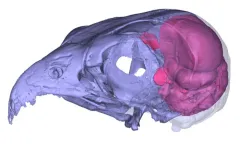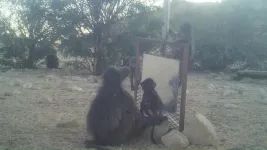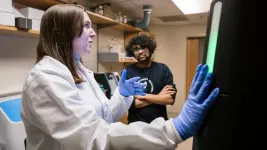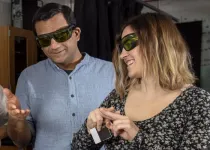(Press-News.org) A new peer-reviewed paper from experts at the Oxford Internet Institute, University of Oxford, highlights the need for a clear framework when it comes to AI research, given the rapid adoption of artificial intelligence by children and adolescents using digital devices to access the internet and social media.
Its recommendations are based on a critical appraisal of current shortcomings in the research on how digital technologies’ impact young people’s mental health, and an in-depth analysis of the challenges underlying those shortcomings.
The paper, “From Social Media to Artificial Intelligence: Improving Research on Digital Harms in Youth,” published 21 January in The Lancet Child and Adolescent Health, calls for a “critical re-evaluation” of how we study the impact of internet-based technologies on young people’s mental health, and outlines where future AI research can learn from several pitfalls of social media research. Existing limitations include inconsistent findings and a lack of longitudinal, causal studies.
The analysis and recommendations by the Oxford researchers are divided into four sections:
A brief review of recent research on the effects of technology on children’s and adolescents’ mental health, highlighting key limitations to the evidence.
An analysis of the challenges in the design and interpretation of research that they believe underlie these limitations.
Proposals for improving research methods to address these challenges, with a focus on how they can apply to the study of AI and children’s wellbeing.
Concrete steps for collaboration between researchers, policymakers, big tech, caregivers and young people.
“Research on the effects of AI, as well as evidence for policymakers and advice for caregivers, must learn from the issues that have faced social media research,” said Dr Karen Mansfield, postdoctoral researcher at the OII and lead author of the paper. “Young people are already adopting new ways of interacting with AI, and without a solid framework for collaboration between stakeholders, evidence-based policy on AI will lag behind, as it did for social media.”
The paper describes how the impact of social media is often interpreted as one isolated causal factor, which neglects different types of social media use, as well as contextual factors that influence both technology use and mental health. Without rethinking this approach, future research on AI risks getting caught up in a new media panic, as it did for social media. Other challenges include measures of social media use that are quickly outdated, and data that frequently excludes the most vulnerable young people.
The authors propose that effective research on AI will ask questions that don’t implicitly problematise AI, ensure causal designs, and prioritise the most relevant exposures and outcomes.
The paper concludes that as young people adopt new ways of interacting with AI, research and evidence-based policy will struggle to keep up. However, by ensuring our approach to investigating the impact of AI on young people reflects the learnings of past research’s shortcomings, we can more effectively regulate the integration of AI into online platforms, and how they are used.
“We are calling for a collaborative evidence-based framework that will hold big tech firms accountable in a proactive, incremental, and informative way,” said Professor Andrew Przybylski, OII Professor of Human Behaviour and Technology and contributing author to the paper. “Without building on past lessons, in ten years we could be back to square one, viewing the place of AI in much the same way we feel helpless about social media and smartphones. We have to take active steps now so that AI can be safe and beneficial for children and adolescents.”
Notes for Editors
For more information and interview requests, please contact: Sara Spinks / Veena McCoole, Media and Communications Manager. T: 01865 280528 E: press@oii.ox.ac.uk
The full paper, “From Social Media to Artificial Intelligence: Improving Research on Digital Harms in Youth,” will be published in The Lancet Child and Adolescent Health at 23:30 GMT / 18:30 ET Tuesday 21 January 2025 at https://www.thelancet.com/journals/lanchi/article/PIIS2352-4642(24)00332-8/fulltext
To view a copy of the paper before this under embargo, contact Sara Spinks / Veena McCoole, Media and Communications Manager. T: 01865 280528 E: press@oii.ox.ac.uk
About the Research
The authors would like to thank Thomas McGrath for help with extraction of details from the reviewed papers, who was supported by a small grant to KLM from the National Institute for Health Research - Oxford Health Biomedical Research Centre – Mental Health in Development theme. TH is supported by the Oxford Internet Institute Research Programme on AI, Government and Politics, funded by the Dieter Schwarz Foundation. Funders of the Jme of individual authors had no role in the content of the manuscript or the decision to submit for publication to Lancet Child and Adolescent Health. All authors had full access to the manuscript and any data relevant to the review and accept responsibility to submit for publication.
KLM, AKP and SG are supported by a grant from the Huo Family Foundation. AKP, NB, MV, and TH are supported by a grant from the Economic and Social Research Council (ESRC) [ES/W012626/1]. AKP is also supported by an additional ESRC grant [ES/T008709/1] and receives funding as a consultant scientific advisor to the Sync Digital Wellbeing Program. AKP and MV are contributing to an ongoing collaboration between the Center for Open Science and Meta. These contributions were solicited by the Center for Open Science and were not subject to approval of Meta. No promises of funding, professional or personal opportunities have been made in exchange for lending Jme and expertise to this project. MV has served as a non-paid panel member for Meta and K-Games.
About the Oxford Internet Institute (OII)
The Oxford Internet Institute (OII) is a multidisciplinary research and teaching department of the University of Oxford, dedicated to the social science of the Internet. Drawing from many different disciplines, the OII works to understand how individual and collective behaviour online shapes our social, economic and political world. Since its founding in 2001, research from the OII has had a significant impact on policy debate, formulation and implementation around the globe, as well as a secondary impact on people’s wellbeing, safety and understanding. Drawing on many different disciplines, the OII takes a combined approach to tackling society’s big questions, with the aim of positively shaping the development of the digital world for the public good. https://www.oii.ox.ac.uk/
About the University of Oxford
Oxford University has been placed number one in the Times Higher Education World University Rankings for the ninth year running, and number two in the QS World Rankings 2022. At the heart of this success are the twin-pillars of our ground-breaking research and innovation and our distinctive educational offer. Oxford is world-famous for research and teaching excellence and home to some of the most talented people from across the globe.
Oxford is world-famous for research and teaching excellence and home to some of the most talented people from across the globe. Our work helps the lives of millions, solving real-world problems through a huge network of partnerships and collaborations. The breadth and interdisciplinary nature of our research alongside our personalised approach to teaching sparks imaginative and inventive insights and solutions.
Through its research commercialisation arm, Oxford University Innovation, Oxford is the highest university patent filer in the UK and is ranked first in the UK for university spinouts, having created more than 300 new companies since 1988. Over a third of these companies have been created in the past five years. The university is a catalyst for prosperity in Oxfordshire and the United Kingdom, contributing £15.7 billion to the UK economy in 2018/19, and supports more than 28,000 full time jobs.
END
Recommendations for studying the impact of AI on young people's mental health proposed by Oxford researchers
2025-01-22
ELSE PRESS RELEASES FROM THIS DATE:
Trump clusters: How an English lit graduate used AI to make sense of Twitter bios
2025-01-22
An English literature graduate turned data scientist has developed a new method for large language models (LLMs) used by AI chatbots to understand and analyse small chunks of text, such as those on social media profiles, in customer responses online or for understanding online posts responding to disaster events.
In today’s digital world, such use of short text has become central to online communication. However, analysing these snippets is challenging because they often lack shared words or context. This lack of context makes it difficult for AI to find patterns ...
Empty headed? Largest study of its kind proves ‘bird brain’ is a misnomer
2025-01-22
It’s difficult to know what birds ‘think’ when they fly, but scientists in Australia and Canada are getting some remarkable new insights by looking inside birds' heads.
Evolutional biologists at Flinders University in South Australia and neuroscience researchers at the University of Lethbridge in Canada have teamed up to explore a new approach to recreating the brain structure of extinct and living birds by making digital ‘endocasts’ from the area inside a bird skeleton’s empty cranial space.
Published today in Biology Letters, the study led by the ‘Bones and Diversity Lab’ at Flinders and the Iwaniuk Lab at the University ...
Wild baboons not capable of visual self-awareness when viewing their own reflection
2025-01-22
Published today in Proceedings of the Royal Society B, the study found that while the baboons noticed and responded to a laser mark shone on their arms, legs and hands, they did not react when they saw, via their mirror reflection, the laser on their faces and ears.
It was the first time a controlled laser mark test has been done on these animals in a wild setting and strengthens the evidence from other studies that monkeys don’t recognise their own reflection.
The researchers observed 120 Chacma ...
$14 million supports work to diversify human genome research
2025-01-21
Washington University School of Medicine in St. Louis has received two large grants renewing funding for the Human Pangenome Reference Sequencing Project. This ambitious program began in 2019 with the goal of increasing the diversity of human genome sequences that are pooled into the widely used reference genome. A thorough representation of human genetic diversity can help researchers discover how genetic variation contributes to disease and perhaps offer new routes to innovative treatments.
Funded by the National Human Genome Research Institute ...
New study uncovers key mechanism behind learning and memory
2025-01-21
AURORA, Colo. (Jan. 22, 2025) – A breakthrough study published today in the Journal of Neuroscience sheds new light on how brain cells relay critical information from their extremities to their nucleus, leading to the activation of genes essential for learning and memory.
Researchers have identified a key pathway that links how neurons send signals to each other, or synaptic activity, to the expression of genes necessary for long-term changes in the brain, providing crucial insights into the molecular processes underlying memory formation.
“These findings illuminate ...
Seeing the unseen: New method reveals ’hyperaccessible’ window in freshly replicated DNA
2025-01-21
San Francisco—January 21, 2025—DNA replication is happening continuously throughout the body, as many as trillions of times per day. Whenever a cell divides—whether to repair damaged tissue, replace old cells, or simply to help the body grow—DNA is copied to ensure the new cells carry the same genetic instructions.
But this fundamental aspect of human biology has been poorly understood, chiefly because scientists lack the ability to closely observe the intricate process of replication. Attempts to do so have relied on chemicals that damage the DNA structure or strategies ...
Extreme climate pushed thousands of lakes in West Greenland ‘across a tipping point,’ study finds
2025-01-21
West Greenland is home to tens of thousands of blue lakes that provide residents drinking water and sequester carbon from the atmosphere. Yet after two months of record heat and precipitation in fall 2022, an estimated 7,500 lakes turned brown, began emitting carbon and decreased in water quality, according to a new study.
Led by Fulbright Distinguished Arctic Scholar and University of Maine Climate Change Institute Associate Director Jasmine Saros, a team of researchers found that the combination of extreme climate events in fall 2022 caused ecological change that ...
Illuminating an asymmetric gap in a topological antiferromagnet
2025-01-21
Topological insulators (TIs) are among the hottest topics in condensed matter physics today. They’re a bit strange: their surfaces conduct electricity, yet their interiors do not, instead acting as insulators. Physicists consider TIs the materials of the future because they host fascinating new quantum phases of matter and have promising technological applications in electronics and quantum computing. Scientists are just now beginning to uncover connections between TIs and magnetism that could unlock new uses for these exotic materials.
A ...
Global public health collaboration benefits Americans, SHEA urges continued support of the World Health Organization
2025-01-21
The Society for Healthcare Epidemiology of America (SHEA) wants to emphasize the importance of global partnerships in addressing health threats that impact all of us, as Americans and global citizens. We urge President Trump to reconsider the decision to terminate the U.S. relationship with the World Health Organization (WHO). The most effective way to address emerging health threats is through collaborative efforts with international partners. Eliminating U.S. involvement in the WHO would leave our country—and the world—more vulnerable to infectious diseases and less prepared to manage pandemics, fight emerging health threats, ...
Astronomers thought they understood fast radio bursts. A recent one calls that into question.
2025-01-21
Astronomer Calvin Leung was excited last summer to crunch data from a newly commissioned radio telescope to precisely pinpoint the origin of repeated bursts of intense radio waves — so-called fast radio bursts (FRBs) — emanating from somewhere in the northern constellation Ursa Minor.
Leung, a Miller Postdoctoral Fellowship recipient at the University of California, Berkeley, hopes eventually to understand the origins of these mysterious bursts and use them as probes to trace the large-scale structure of the universe, a key to its origin and evolution. He had written most of the computer code that allowed ...





